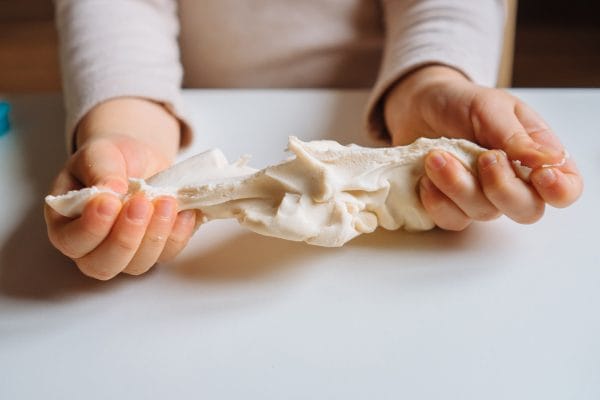The Ultimate Guide to Homemade Playdough: Benefits, Recipes, and Tips
Playdough has been a staple in children’s play for generations, offering endless hours of creative fun and developmental benefits. With the rising interest in DIY crafts and the move toward more natural, non-toxic play materials, making homemade playdough has become a popular activity for parents and educators alike.
In this article, we will delve into the world of homemade playdough, exploring the benefits of making your own, providing the best homemade playdough recipe, and sharing tips for success.

Benefits of Homemade Playdough
![]()
Before we jump into the specifics of how to make playdough at home, let’s consider why you should give it a try:
- Safety: Homemade playdough is non-toxic, and you control what goes into it. This is particularly important for younger children who might be tempted to taste their creations.
- Cost-effective: Making your own playdough can save money in the long run since the ingredients are common household items that are inexpensive to purchase.
- Customizable: You can adjust the texture, colors, and even scents according to your preferences or themes you’re exploring with your children.
- Educational: The process of making the playdough can be a learning experience in itself, teaching kids about measurements, following instructions, and the science of how ingredients combine to create something new.
Ingredients for Homemade Playdough
![]()
The basic ingredients for homemade playdough are simple and likely already in your pantry:
- Flour
- Salt
- Cream of tartar (acts as a preservative and helps with elasticity)
- Water
- Vegetable oil
- Food coloring (optional)
Some recipes may include additional components like glycerin for shine and stretchiness, or natural dyes for color. The choice of ingredients can affect the final product, so feel free to experiment to find what works best for you and your family.
The Best Homemade Playdough Recipe
![]()
Now let’s get to the main event: the best homemade playdough recipe. This tried-and-tested formula yields a soft, pliable dough that lasts for months if stored properly.
Homemade Playdough with Cream of Tartar
This classic recipe is celebrated for its smooth texture and longevity:
- 1 cup of flour
- 1/4 cup of salt
- 2 teaspoons cream of tartar
- 1 cup of water
- 1 tablespoon of vegetable oil
- Food coloring (as desired)
Instructions:
- In a large pot, mix the flour, salt, and cream of tartar.
- Add the water and vegetable oil to the dry ingredients and stir until well combined.
- Cook the mixture over medium heat, stirring constantly, until it thickens into a doughy ball.
- Remove from heat and allow the dough to cool slightly before handling.
- Place the dough on a surface and knead it until smooth.
- If you’re using food coloring, divide the dough into the number of colors you want to make and knead in the color until evenly distributed.
- Allow the playdough to cool completely before giving it to children to play with.
Once cooled, store the homemade playdough in an airtight container to keep it soft and pliable.
Making Homemade Playdough: Tips for Success
![]()
Creating the perfect batch of homemade playdough can be as much of an art as it is a science. Here are some helpful tips to ensure your success:
- Knead Well: The more you knead the dough after cooking, the smoother it will become.
- Color Wisely: Gel food coloring can produce more vibrant colors than liquid food coloring and usually requires less to achieve the desired shade.
- Preserve It: Always store your playdough in an airtight container or bag to prevent it from drying out. If it does begin to dry, you can sometimes revive it by kneading in a few drops of water.
- Non-toxic: Ensure all materials and surfaces used are non-toxic and safe for kids, especially if they are prone to putting things in their mouths.
- Involve Your Child: Making playdough can be a fun activity for kids, too. Allow them to help with pouring and mixing ingredients (with supervision) and choosing colors.
How Do You Make Homemade Playdough Without Cream of Tartar?
![]()
While cream of tartar is a key ingredient in many playdough recipes for its preservative and elastic properties, there are alternatives. Here’s how you can make homemade playdough without cream of tartar:
- Replace cream of tartar with an equal amount of lemon juice or white vinegar to help preserve the dough and provide elasticity.
- Follow the same recipe instructions as above, substituting your chosen alternative for the cream of tartar.
Keep in mind that while playdough made without cream of tartar can still be quite enjoyable, it may not last as long as the traditional version.
Frequently Asked Questions
![]()
What ingredients do I need to make homemade playdough?
To make homemade playdough, you typically need flour, salt, water, vegetable oil, cream of tartar, and food coloring (optional for color). A basic recipe might include 1 cup of flour, 1/4 cup of salt, 1/2 cup of water, 1 tablespoon of oil, and 2 teaspoons of cream of tartar.
How do I make homemade playdough?
Mix the flour, salt, and cream of tartar in a pot. Add the water and oil, and if you’re using food coloring, add it to the water before mixing. Cook over medium heat, stirring constantly until the dough forms and begins to pull away from the sides of the pot. Let it cool before kneading.
Can I make playdough without cream of tartar?
Yes, you can make playdough without cream of tartar by substituting it with lemon juice or white vinegar. The purpose of cream of tartar is to improve elasticity, but these substitutes can work in a pinch.
How long does homemade playdough last?
Homemade playdough can last for several months if stored properly. Keep it in an airtight container or a ziplock bag to prevent it from drying out.
Is homemade playdough safe for children?
Homemade playdough is generally safe for children, as it is made with edible ingredients. However, it is not meant for consumption, so always supervise young children during play to avoid accidental ingestion.
Can I make gluten-free playdough?
Yes, you can make gluten-free playdough by using gluten-free flour in place of regular flour. Keep in mind that the texture may be slightly different due to the flour substitute.
How can I add color to my homemade playdough?
You can add color to your homemade playdough by mixing in a few drops of food coloring to the water before you combine it with the dry ingredients. You can also knead in the color after the dough has cooled.
What should I do if my playdough is too sticky?
If your playdough is too sticky, try adding a little bit more flour and knead it until the desired consistency is reached. Be careful not to add too much, or the dough may become dry and crumbly.
Can I add scents to my playdough?
Yes, you can add scents to your playdough by incorporating a few drops of child-safe essential oils or extracts like vanilla or almond extract. Always make sure the scents are non-toxic and safe for children.
My playdough dried out. Can I revive it?
If your playdough has dried out, you can try to revive it by kneading in a small amount of water until it becomes pliable again. If it’s too dry, it may be beyond repair and you might need to make a new batch.
Conclusion: The Joy of Homemade Playdough
![]()
Homemade playdough offers a myriad of benefits, from being a safe and non-toxic option for kids to providing an affordable and customizable alternative to store-bought play materials. Whether you follow the best homemade playdough recipe with cream of tartar or opt for a cream of tartar-free version, you’ll find that making homemade playdough is a rewarding and fun experience for both children and adults.
By embracing the process of making homemade playdough, you foster a hands-on, creative environment that encourages learning and development through play. So, roll up your sleeves, gather your ingredients, and prepare to create not just playdough, but also precious memories with your little ones.

